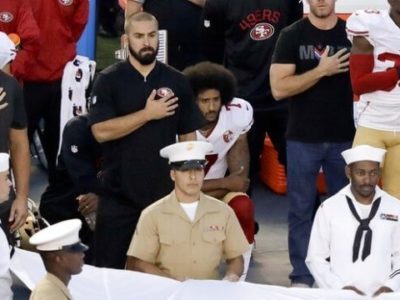“I alone cannot change the world, but I can cast a stone across the waters to create many ripples,” Mother Teresa said. Colin Kaepernick’s stone hard stance against the issues of African American oppression, specifically in regards to police brutality in the United States, has erupted into a ripple effect of criticism, support and conversation. The San Fransico 49ers quarterback’s conscience decision to kneel during the national anthem invokes thought and question. Are Kaepernick and his supporters right, or does his opposition create valid sources of criticism? The debated right and wrongs fail to matter. Ultimately, understanding on both sides induces change, conversation and bolsters peaceful protest.
Kaepernick exercised his rights as an American citizen first when he sat during the national anthem before a preseason matchup against the Green Bay Packers in August. “I am not going to stand up to show pride in a flag for a country that oppresses black people and people of color,” Kaepernick said to NFL media. “To me, this is bigger than football, and it would be selfish on my part to look the other way.” When he refers to “this,” he expresses his disgust with an ongoing epidemic of obvious discrimination against African Americans and minorities across the nation. Since then, Kaepernick continues to defy the anthem in the form of kneeling while supporters begin to arise against the same issue and follow suit. But the opposition, although seemingly agreeing upon the overall issues with police brutality, find fault in Kaepernick’s platform. If you don’t know as much about this brewing situation, you probably find confusion in your stance, just as I did, but each side has their own reasons for how their actions appropriately reflect their position on the issues at hand.
The 49ers quarterback’s opposition takes issue with his platform because of his disrespect towards the national anthem, which seemingly correlates to the disregard for the efforts of current and veteran military members and the United States as an entire entity. Furthermore, Kaepernick has experienced backlash from the military because without their courageous deeds and the symbolic gesture of the stars and stripes, he would fail to freely bring such an issue to light. Especially on such a large platform. Kaepernick’s past fashion and political statements also do not help support his good intentions; he has been seen wearing socks with clear depictions of pigs in police uniforms and a Fidel Castro shirt to a press conference. Also, in terms of the game itself, the opposition finds negativity in its impact on NFL football because it disrupts football’s common ground between the liberal and conservative divisions in America.
Notable opposers lay in the way of Drew Brees, Roger Goodell and Jerry Rice. They acknowledge the need for change, but find issue with the blatant objection to the United States, the flag and the values and disciplines that founded our country in 1776. Instead of trashing the foundation of the nation with Kaepernick’s own restructuring, the opposition finds opportunity in protests that utilize America to revitalize support, positivity and peace. Essentially, the disagreement lies within Kaepernick’s actions, not his thoughts.
While the other side reads well with clear-cut emphasis on the quarterback’s disrespect for the red, white and blue, Kaepernick’s stance begs a more complex understanding of why, who and what. His “why” stems from the need to raise awareness to the injustices that many Americans think ended with the Civil Rights Movement in the 1960s. Since his protest spread across the nation like rapid fire, after every kneel a new athlete pledges their allegiance to his campaign of protest. With new supporters comes new definitions to add to the awareness; “It was very intentional…It was a little nod to [Colin] Kaepernick and everything that he’s standing for right now,” Megan Rapinoe, Seattle Reign midfielder, said to American Soccer Now about her calculated action to kneel during her soccer match’s national anthem. “We need to have a more thoughtful, two-sided conversation about racial issues in this country…Being a gay American, I know what it means to look at the flag and not have it protect all of your liberties…It’s important to have white people stand in support of people of color on this.”
The “who” of Kaepernick’s “what” has slowly began to formulate into a supportive system of athletes across the nation with the likes of Eric Reid, Kaepernick’s teammate, Brandon Marshall, linebacker for the Broncos, and the Seattle Seahawks football team. Even President Barack Obama utilized his status to bolster the quarterback’s campaign during the G20 Summit. After reading thus far, some may also be surprised to know veteran Nate Boyer stepped in to ease Kaepernick’s transition from back-up quarterback to activist. With thoughtful consideration, Kaepernick employed Boyer’s advice to kneel instead of sit during the national anthem to instill a more symbolic and respectful manner of protest.
Kaepernick’s campaign gains more ground because the “who” and the “why” are now creating a what. What exactly is his stance inspiring across a troubled nation? One word: conversation. Instead of the backlash of physical violence, individuals are utilizing their American rights to portray a desire for change with peaceful action and (mostly) thoughtful conversation.
No sides need to be drawn or joined though. There needs to be an understanding between those on both teams because there remains no right or wrong. Rather, there’s an appreciation for the positives of America and a call to action for the discrimination and injustices still plaguing genders, race, sexual orientation and other groups across the nation. Remember the red, white and blue we bare connects us through the past, present and future.



















